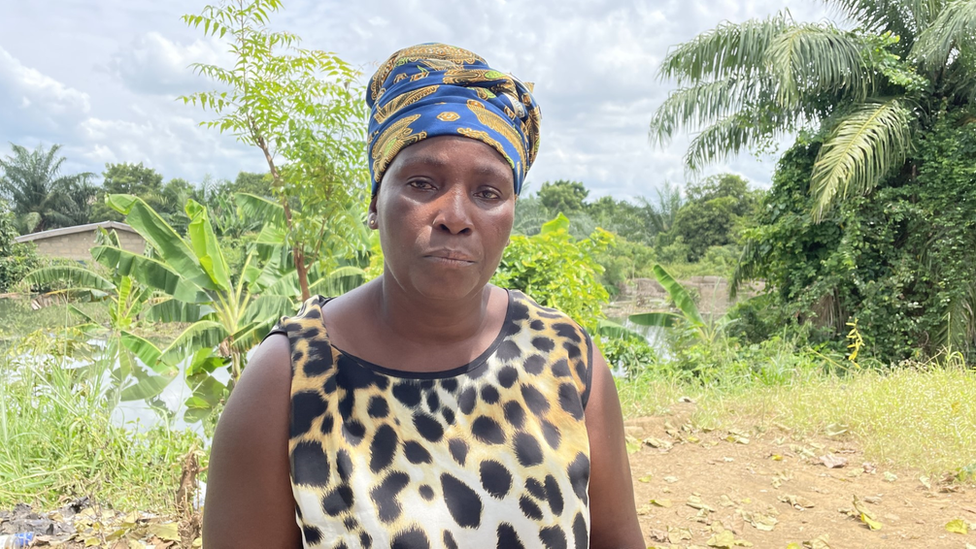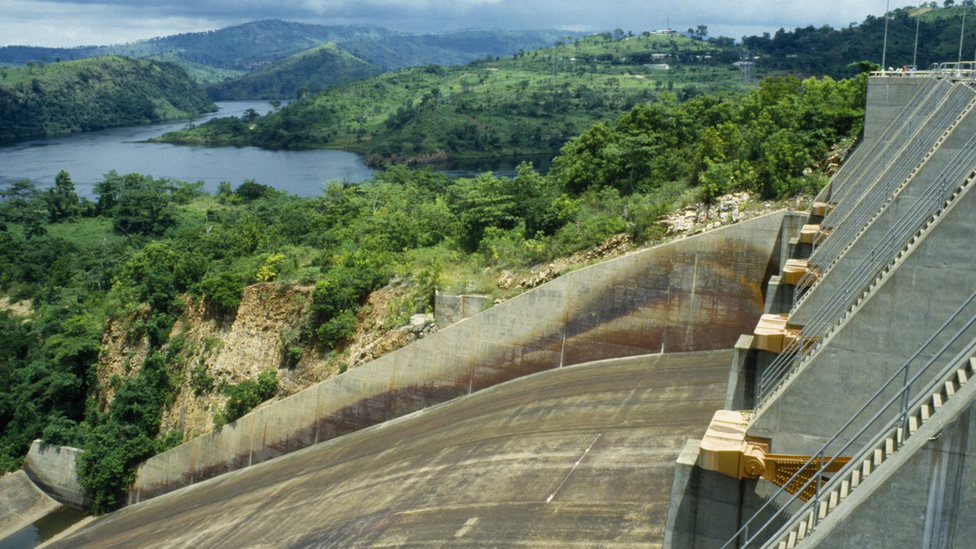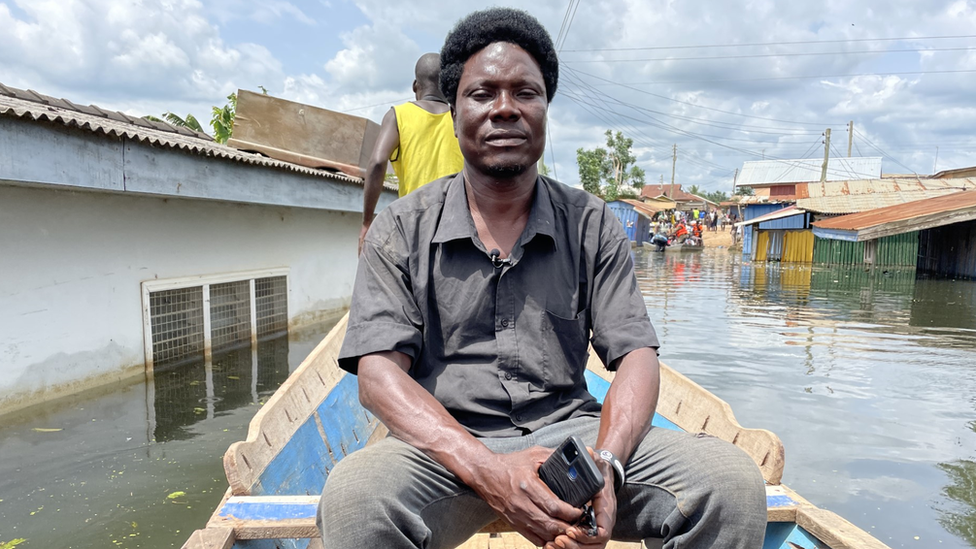Ghana floods: ‘My entire farm is under the water and so is my house’
- Published

Awusife Kagbitor says her entire house is under water
Awusife Kagbitor paces anxiously on a dry patch of land overlooking her collapsed and completely submerged three-bedroom home in Mepe in Ghana's Volta Region.
She says she saw water gushing into her house from a nearby stream, and within 10 minutes the water level had reached her neck. On hearing that his mother's home was flooding, her son Kenneth rushed to the scene and swam his way through the rising waters to save his mother and young siblings.
The 56-year-old farmer is one of thousands of victims of the floods in south-east Ghana. It is a disaster she is struggling to come to terms with. They were taken unawares and could not salvage anything, she tells me as beads of tears roll down her face.
"My entire farm is under the water and so is my house. I was only able to take my clothes. It took me about 14 years to build this house - there is nowhere to go, there is no other land to build on," Ms Kagbitor said.
Her fate is shared by nearly 26,000 others, displaced by floods caused by the controlled spillage of excess water from the Akosombo and Kpong hydro-electric dams near the southern tip of Lake Volta.
What caused the floods?
Ghana has been experiencing unpredictable rainfall patterns for months now, which many scientists say is the result of climate change.
Heavy rains have significantly increased the volume of water in the two dams, and officials of the Volta River Authority, the electricity company that manages the dams, started the "controlled spillage" of the facilities a month ago.
They say that the maximum safe operational level of the Akosombo dam is 277.5 ft (84.6m). If the water behind the dam reaches any higher, it could burst.
The water level recently peaked just below this - around 277.26 ft, compelling them to "spill" excess water to prevent a catastrophe which could have dire consequences.

The Akosombo dam was built in the 1960s to provide energy to industrialise the country
The Akosombo and Kpong Dams generate about a third of Ghana's energy mix. The authorities say they will reduce the rate of spillage of the dams while monitoring the volume of water upstream.
The Akosombo dam was built in the 1960s, a project championed by Ghana's first President Kwame Nkrumah to provide much-needed energy to industrialise the country.
Its construction flooded parts of the Volta River Basin in the eastern region of southern Ghana and around 80,000 people had to be relocated.
It also led to the creation of the Volta Lake, the largest man-made lake in the world by surface area.
The dam has subsequently been spilled when needed, with limited impact on communities. However, this year's flooding is one of the worst to hit the more than 100 communities living downstream since the dam's creation.
How serious are the floods?
The National Disaster Management Organisation estimates that eight districts have been affected since the flooding started on Wednesday 11 October.
Many homes have been completely submerged and authorities are only beginning to assess the impact of the floods.
About a quarter of the Mepe community in an area we visited has been seriously impacted by the water.
Toilet facilities, cemeteries and refuse dumps have all been flooded, raising serious concerns about the outbreak of disease. Essential services like water and electricity are no longer reaching the affected areas.

Like many others, Ahorsu Amos Borlor now has to get around by boat
Local official Ahorsu Amos Borlor said that residents ignored his repeated warnings to take precautionary measures when the spillage started.
"There are about 15 communities in the lower Volta basin. Eight of them have been greatly affected, farmlands have been washed away, so economic activities have been greatly affected. We are feeling bad, our livelihood has been taken away, this is not how we live," said Mr Borlor.
Local resident Brian Foekpa is still reeling from the disaster. He says the flooding happened so quickly he could not take any of his belongings and could only save his family.
"The bike I use for my okada [motorcycle taxi] business is in the room that collapsed, so it has affected me. No food to eat. My farm has been washed away by the floods. As I'm talking to you, these clothes I have on me now are the only ones I have."
The Volta River Authority says it warned residents in the area ahead of the spillage. The power company also carried out simulation exercises with some communities about how to deal with a potential disaster, but that does not seem to have lessened the impact of the floods.

Ghana's navy has been called it to help
Ghana's navy has been assisting with rescue efforts. It says it has rescued more than 8,000 people so far.
The Deputy Director General of the National Disaster Management Organisation (Nadmo), Seji Saji, attributes the floods to heavy rains brought about by climate change.
"The heavy inflows from upstream of the Volta dams can only be explained by the volume of water that we are receiving from Burkina Faso to the northern region because those form the catchment areas of the Volta dams," he said.
"The quantum of water coming is very serious and we can only explain this with the issue of global warming and climate change."
He added that they have set up several holding areas for people displaced from their homes and are providing some relief aid.
However, with more rains predicted, the water levels of the dams will keep rising - and so will the numbers of the displaced, and people like Ms Kagbitor will only be able to look on as their lives and livelihoods disappear under water.